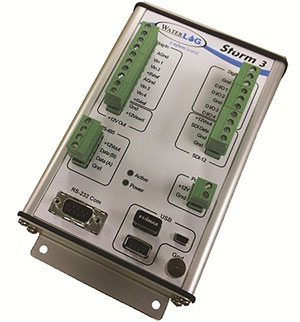Identifying the Best Data Logger
Customers around the world ask us the same question: What data logger is right for me? We get it - there are a lot of choices out there. Sometimes it's nice to have a little direction to get you started down the selection path. That's why we asked our most experienced service technicians to share their top six tips for selecting the best Data Logger for your application.
Step 1 - Parameters to Monitor
What do you want to measure?
Once the parameters you want to measure are defined, then the appropriate sensors available can be selected. Sensors output their signal in a variety of different outputs and not all data loggers can read the output of all sensors. Typical sensor outputs will include analog, digital, and frequency.
Analog sensors provide a voltage or amperage signal that is directly related to the parameter being measured. For example, an analog submersible pressure transducer used to measure water level may output its signal in a 4-20 or 0-20 mA, 0-1, 0-5, or a 0-10 mV range.
A digital signal may be an RS232 serial string. It may also output data in specific communication protocols like SDI-12, MODBUS, or DNP3. Select the data logger that can read the signal of the sensor you have selected.
It is also important to know the number of sensors desired. The data logger you select needs to provide enough ports or channels to read all the sensors you need. Some data loggers have the ability to add additional channels, while others are fixed. Take into consideration any future growth of the number of parameters that may be needed.
Step 2 - Scan Rate & Record Rate Needed
How fast do you want to measure the parameter and how often do you want to record the data?
Scan rate refers to how often the data logger is going to retrieve a reading from the sensors. The record rate is how often the data logger is going to save or log the data.
Common logic and understanding of your project needs must be used to determine what is really needed. Although the data logger may be able to scan a sensor once every second, you must ask if it is really needed? Scanning a sensor once every minute and recording the average of those one-minute scans every 15 minutes may make more sense. However, if scanning the sensor 10 times per second (10 Hz) is required for the application, then a data logger that can scan at that frequency needs to be used
Step 3 - Memory Recorded
Memory refers to the amount of data stored in the data logger before it either stops recording or writes over old data with new data.
Most data loggers refer to memory in bytes. More information is required to determine how many data points can be recorded. The number of bytes required for each data point is needed to determine how long a data logger can record data. For example, a data logger that provides 256 megabytes and requires 8bytes per data point would then provide 32,000,000 data points. If a system recorded 5 data points every 15 minutes, the memory would be filled in 182.6 years. As can be seen, for typical environmental data recording, memory size is rarely an issue.
Step 4 - Accuracy
Accuracy refers to how close the measured value recorded by the data logger is to the actual value being measured.
The accuracy of the data logger is only relative when the data logger is converting an analog signal to digital measurement. When considering the accuracy of the data being recorded, the accuracy of the sensor itself needs to be addressed.
The Analog-to-Digital (A/D) conversion is stated in bits. A data logger may have an A/D 16 specification. This value can often be used inaccurately to indicate the accuracy and precision of measurement when this is not the case. Even a data logger that specifies A/D 24 may be less accurate than a data logger with A/D 12.
Many sensors now available are considered smart sensors. These sensors convert the analog signal to a digital signal themselves. The digital signal is then output directly to the data logger. The accuracy of the data logger, in this case, is irrelevant while the accuracy of the sensor is what is important.
Depending on the needs of your application will determine how accurate the data needs to be
Step 5 - Communication
There are two primary reasons that communicating with the data logger is necessary. One is to configure or program the data logger to do what you want it to do; what type of sensor will be connected, how often to scan the sensor, and how often to record the data. The second reason is to retrieve the data from the data logger.
A data logger that is used in a laboratory application is most often connected directly to a PC or uses an integrated keypad display, whereas a data logger that is installed in a remote location may use a digital cell modem, satellite transmitter, or radio.
Many remote data loggers use GOES satellite transmitters to send the recorded data back to a central repository and require a direct connection, keypad display, or a second wireless connection to program the data logger.
Other data loggers allow the use of WiFi or Bluetooth connections to laptops, tablets, and smartphones. These are very convenient although do have distance limitations.
Step 6 - Software
The software provides the user interface for communicating with the data logger using a PC, laptop, tablet, or smartphone. There will be a range of offerings from very simple to complex, to residing on the computer or browser-based systems.
Software that does not provide the access to the data you need or is difficult to use will be a source of continual frustration. This qualifies the software to receive serious consideration when selecting a data logger.
